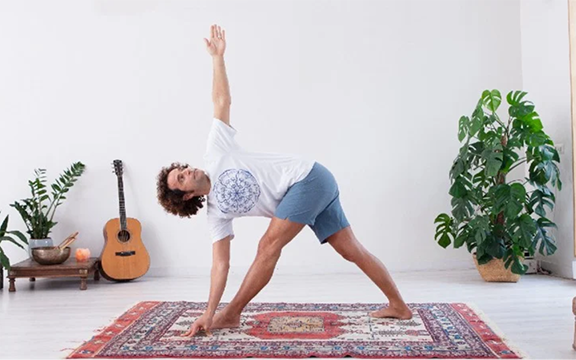 What’s better: Yoga at home or in-person class? I think they both work. It’s lovely to follow the teacher’s sequences and be with your Yoga friends—but an integral part of developing understanding of yourself and of Yoga is establishing a home practice, tailor made for you and easily available, at home or away. All you need is motivation—that’s the hard part.
What’s better: Yoga at home or in-person class? I think they both work. It’s lovely to follow the teacher’s sequences and be with your Yoga friends—but an integral part of developing understanding of yourself and of Yoga is establishing a home practice, tailor made for you and easily available, at home or away. All you need is motivation—that’s the hard part.
I love Yoga, and if I was a really inspired yogini, instead of my occasionally reluctant self, I would always be motivated to practice asana, meditation, and pranayama, but I am not, I just do it anyway—even when I don’t feel like it—as has been my habit for the last almost 60 years. As Curtis Mayfield advises in song, “I just keep on keeping on.” Let me tell you about it.
I always have time to do something at home; even it’s just a little bit. Since I don’t automatically want to practice Yoga every morning, I like to make my practice easy to get into. For example, when I’m home I don’t use a mat; it feels like too much trouble; I just lie down on my rug, like in the old days before Yoga mats were invented. My home routine takes less than an hour every morning, and then later on I might take a Yoga class at my local studio.
The essence of my home practice starts from the basics that I learned in Integral Yoga Teacher Training. Most mornings I start with supported back bends, deep breathing, then tougher core work, hip openers, and a few twists. Right now I’m also concentrating on opening my shoulders, chest and arms; these are all moves my body really needs; I can always do more if I feel like it and I have the time. The physical practice probably lasts about 20 minutes, wakes me up, and is a prelude to pranayama and meditation, which can be sweet, or boring and tedious—it doesn’t matter one iota. It’s the doing that counts.
A program on my very smart phone helps me keep track of the meditation part of my practice, kind of like a techy sadhana chart. Since I can’t bear to disappoint my phone I have to meditate, even though I’m beginning to suspect that my phone doesn’t really care very much about my spiritual development. And if I want to meditate I need to do pranayama first, and really, a little movement before that wakes me up and helps me sit still, and I breathe better. One thing leads to the other, like beads on a mala.
After my home practice, when able to take in-person Yoga classes, I often take a class which includes asanas I may not have done earlier in the day. I enjoy the camaraderie of seeing my friends. I like relinquishing my process to the teacher’s sequences, imagination, and directions, and the personal connection I feel with my community is vital. I have support if I reach tough, sad, frightening, angry parts inside; after all none of us is filled only with peace, joy, love and compassion. We all have to travel through the desert before we can find an oasis, and sometimes traveling companions help.
I used to think my home Yoga practice was too simple to count for much. When I thought it over, though, I figured out that simplicity is what makes my practice work.
- I keep it simple on purpose—the practice is elegant and accessible.
- Conditions are never perfect. That’s real life- street noise from construction (I live right near the 2nd Avenue Subway in New York City), it’s too hot, too cold, I’m not in the mood, and I’ll start tomorrow when everything is under control—but everything will probably never be completely under control, so I accept and continue.
- Speaking of control, when my grandchildren are visiting my practice is very different: home Yoga becomes group practice and an opportunity for me to feel grateful and be flexible, and play with the kids. There are many kinds of Yoga, and kids’ Yoga is fun!
- When my grandchildren are not visiting, which is most of the time, I have an opportunity to do a more solitary and concentrated practice, but I am still not home alone, my husband and our cats are there too. I let my husband know ahead of time not to disturb me. I used to feel a little guilty about this and worry that it would have a bad effect on our relationship, but it shouldn’t and in fact it doesn’t. This is called mutual respect. My perceptive cat, Bella, lies down and meditates to keep me company; Fifi is more active, so she leaves the room on her own just before I shut the door and begin.
- I am lucky enough to have a door that I can shut. In the past I used a corner of the living room. Yoga doesn’t take up much space.
- I pretend I’m away someplace else. This means that my husband gets to decide on his own if his tie goes with his shirt, and he knows he can’t expect me to be social and discuss the latest headlines in the morning paper. In short, he also makes believe I’m not home, but he knows that I will be there for him later. And I know that too.
- The ringing phone? I don’t answer it. In fact, I shut it off. This is called the “just because the phone rings, it doesn’t mean you have to answer” asana. I make my environment conducive to my practice. (This phone ring asana works in many contexts: just because the first cookie tastes good, doesn’t mean I have to eat three more, just because my right shoulder and then my ear itch when I’m meditating, doesn’t mean I have to scratch, I’m not a computer constructed to simply react to a stimulus.)
- The words “home Yoga practice” are intimidating, to me, at least, because they sound so official. Doesn’t it mean that I should be doing lots more, longer, harder, better, etc.? (Can you tell I’m from New York?) Just as I eliminated outside demands, I can eliminate the inner ones and relax and enjoy the sensations of breath and movement. When I do Yoga asana, at home and in class, I often have my eyes closed, so I can go deep and not be distracted.
- I practice in the morning, because I know the longer I wait, the more excuses I’ll find to skip it. And those excuses get more convincing as the day goes on. Also, later in the day I have less energy. Other people may find afternoons or evenings more conducive.
- I don’t always have the time. I get up pretty early and mostly do have the time—if I’m pressed, I do less—but I always do something. This is thanks to Swami Satchidananda, who taught that a little every day is better than a lot once in a blue moon. Consistency creates its own energy.
- Some of my friends and colleagues literally give themselves a class, talking out loud to themselves as though they were the students in their own class. I prefer to be silent—I get closer to what I need, to who I am, minute by minute when I am quiet—but there are many ways and they are all valid.
Learning your way to practice Yoga is vital to developing a close following of your inner needs. The teacher is providing nourishment for a whole class, after all, not just for you, and what’s on the menu that day may not be entirely satisfying or even appropriate. In your private home practice you can learn to feed yourself more exactly what you need in the moment and you can work out deeper understandings of what you’re doing. You can work on something you find challenging or you can relax into the asanas that you love best.
If you are like me, scared to open your mat on the floor, at home and by yourself, try doing just a little bit, nothing too intimidating, and see what happens. How about simple stretches, a few cat/cows? Many of us know sequences we can follow, or we can go where our body leads us. Your practice doesn’t have to be long, unless you want it that way. Stay flexible and committed, doing your best, and doing what suits you. Let go of expectations, release thoughts about the past, leave behind fears or anxieties about the future, with or without a teacher. This is the art and the heart of Yoga.
There are many roads, as Sri Swami Satchidananda said. Try them.
About the Author:

Lynn Anjali Somerstein, PhD, RYT, is a psychotherapist in private practice in Manhattan and studied and taught Yoga at the Integral Yoga Institute of New York. She was the Director of the Institute for Expressive Analysis for six years. Her interests include using the breath and meditation to allay anxiety, stress and depression. She’s published many articles and addressed many conferences in the US and abroad, including India, Turkey and at the University of Beijing, where she taught how to use the breath to allay anxiety in the psychotherapeutic encounter. For more information, please visit: lynnsomerstein.com.

